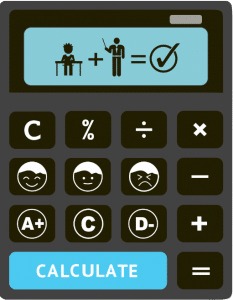Overview
Geometry is an important part of year 5 maths. You’ll learn about angles, transformations, the coordinate grid and other things related to space and measurement.
Learning Outcomes
By the time you finish reading this article, you will
- Know how to measure angles with a protractor
- Understand the concept of nets
- Understand what a coordinate grid is and how to read and write the coordinates of objects
- Understand basic transformation
Measuring Angles with a Protractor
In year 4, you learnt about the different types of angles – acute, right, obtuse, straight, and reflex. Now, you will learn how to measure angles.
The instrument used to measure angles is called a protractor. Here’s what it looks like:
Start by placing the protractor on the vertex, the point where the two lines of the angle meet. Then, line up the base of the protractor with one of the lines of the angle. Look at where the other line of the angle intersects with the protractor’s arc. This is the angle measurement. Make sure to read the measurement in degrees and include the degree symbol (°). Remember, if the angle is acute, you should read the smaller number, and if it is obtuse, you should read the larger number. The angle shown below measures 50°.
A clinometer is another instrument that measures angles. It is a tool used to measure the tilt of an object or surface. It can tell you if something is sloping up or down. Engineers and surveyors use clinometers to measure the height of tall things like trees, buildings, or mountains. By measuring the angle, you can figure out how tall the object is!
Nets
In geometry, a net is like a flat pattern that you can fold up to make a 3D shape, kind of like how a box is made from a flat piece of cardboard. Imagine taking a cardboard box apart and flattening it out. The flat, unfolded shape you get is the box’s net.
Nets are useful because they help us understand how 3D shapes are put together and how they look from different angles. By looking at a net, you can see how many sides a shape has, where the corners are, and how the sides are connected.
The following figure is the net of a cuboid.
The Coordinate Grid
So, have you ever played a battleship or any game where you have to find a hidden treasure on a map? Well, the grid coordinate system is similar to those games! It’s a way to find a location on a map using numbers.
Imagine a piece of graph paper with a bunch of little squares. The horizontal lines are like the numbers on a number line. The vertical lines are like the numbers on a number line too, but they go up and down instead of left and right.
Now, when we want to find a location on the map, we need two numbers: one for the horizontal line and one for the vertical line. These numbers are like an address for the location on the map. We write the horizontal number first and then the vertical number. We use brackets to group the numbers together and a comma to separate them.
For example, if we wanted to write down the point that is 3 spaces to the right and 5 spaces up, we would write (3,5). The horizontal coordinate always comes first, followed by the vertical coordinate.
In the figure shown above, the house is at (2, 4), and the ladder is at (7, 1). The flower pot is at (4, 2). So, you should note that (2, 4) is not the same as (4, 2). Remember, the horizontal coordinate comes first.
Understanding Transformations
A transformation can move or turn a shape, but it doesn’t change its size or shape. It’s like moving your chair or turning your head, but you’re still the same size and shape.
There are three types of transformations: translations, rotations, and reflections. Let’s see what they mean.
A translation is like moving a shape from one place to another on the coordinate grid. Imagine picking up a drawing and sliding it to a new spot. The shape stays the same, but its position changes. The figure below demonstrates translation.
A rotation is like turning a shape around a point on the coordinate grid. Imagine turning your head or spinning in a circle. The shape stays the same, but its orientation changes. The figure below demonstrates rotation.
A reflection is like flipping a shape over a line on the coordinate grid. Imagine looking in a mirror or flipping a piece of paper over. The shape stays the same, but its orientation changes. The figure below demonstrates rotation (about the black line, which acts as the mirror).
Wrap Up
As you just saw, there are quite a few topics – the ones we discussed above and a few more – for you to master in year 5 geometry. If you need any help understanding them, feel free to reach out.













